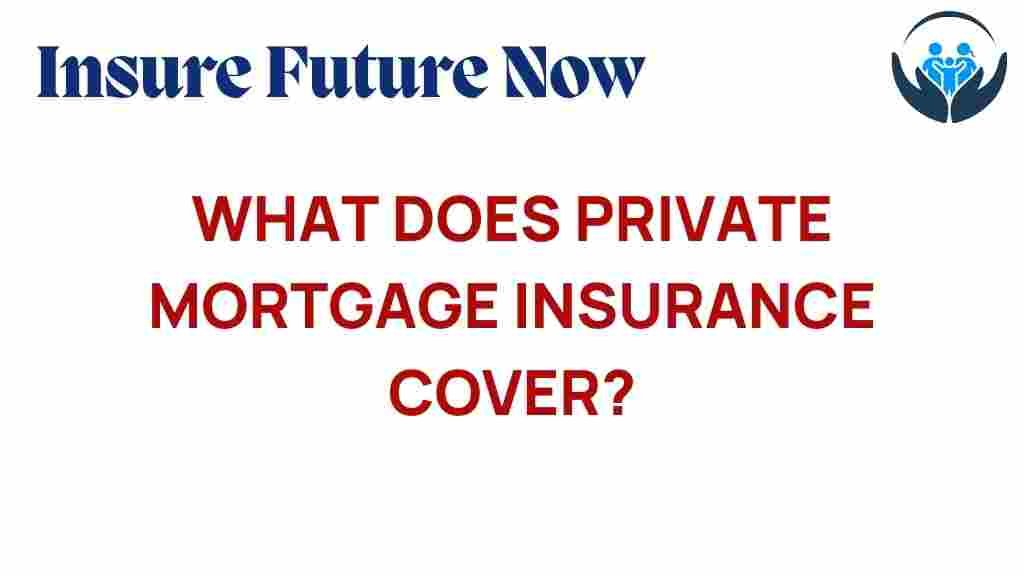Unveiling the Mysteries of Private Mortgage Insurance
When embarking on the journey of home buying, many prospective homeowners encounter the term **Private Mortgage Insurance** (PMI). This essential component of mortgage protection plays a critical role in enhancing financial security while making homeownership more accessible. In this article, we will explore the intricacies of PMI, its coverage details, costs, and how it impacts the home buying process.
What is Private Mortgage Insurance?
Private Mortgage Insurance is a type of insurance that lenders require from borrowers who are unable to make a down payment of at least 20% of the home’s purchase price. Essentially, PMI protects the lender in case the borrower defaults on the loan. This protection allows lenders to offer loans to buyers who may not have substantial savings, thus facilitating homeownership.
Understanding the Necessity of PMI
When buying a home, particularly for first-time buyers, coming up with a significant down payment can be challenging. PMI serves as a safety net for lenders, allowing them to mitigate risks associated with lower down payments. Here’s why PMI is often necessary:
- Lower Down Payments: PMI makes it possible for buyers to purchase homes with down payments as low as 3% to 5%.
- Increased Accessibility: With PMI, more individuals can enter the housing market, promoting homeownership.
- Protection for Lenders: PMI reduces the financial impact on lenders in case of borrower default.
Coverage Details of PMI
The coverage details of Private Mortgage Insurance can vary based on factors such as the lender, loan type, and the borrower’s credit profile. Here are some key points to understand:
- Coverage Amount: PMI usually covers a percentage of the loan amount, typically ranging from 20% to 30%.
- Types of PMI: There are two primary types of PMI: borrower-paid mortgage insurance (BPMI) and lender-paid mortgage insurance (LPMI).
- Duration: PMI is generally required until the borrower reaches 20% equity in the home. At this point, borrowers can request to cancel PMI.
How to Calculate PMI Costs
The costs associated with Private Mortgage Insurance can vary significantly. To estimate PMI costs, consider the following factors:
- Loan Amount: Higher loan amounts typically result in higher PMI premiums.
- Down Payment: A smaller down payment means a higher PMI cost.
- Credit Score: Borrowers with lower credit scores may face higher PMI rates.
To calculate PMI, multiply the loan amount by the PMI rate, which usually ranges from 0.3% to 1.5% of the original loan amount per year.
Step-by-Step Process of Obtaining PMI
Understanding the step-by-step process of obtaining Private Mortgage Insurance can simplify your home buying experience:
- Assess Your Financial Situation: Understand your credit score, savings, and how much you can afford for a down payment.
- Shop for Lenders: Different lenders offer varying PMI rates. Compare multiple lenders to find the best deal.
- Get Pre-Approved: Obtain a pre-approval letter from your chosen lender, which will include PMI estimates.
- Finalize Your Loan: After selecting a home, proceed with the loan application and review the PMI terms.
- Close on Your Home: Sign the closing documents, which will include the PMI details, and take possession of your new home.
Benefits of Private Mortgage Insurance
Despite the additional costs, PMI provides several benefits that enhance the overall home buying experience:
- Access to Homeownership: PMI allows buyers to purchase homes with lower down payments.
- Flexible Options: Borrowers can choose between BPMI and LPMI based on their financial situation.
- Potential Tax Deductions: In some cases, PMI premiums may be tax-deductible, providing additional financial relief.
Common Misconceptions about PMI
There are several misconceptions surrounding Private Mortgage Insurance that can lead to confusion:
- PMI is the Same as Homeowners Insurance: Many confuse PMI with homeowners insurance. While PMI protects the lender, homeowners insurance protects the borrower and their property.
- PMI is Forever: Borrowers can cancel PMI once they achieve 20% equity in their home.
- Only First-Time Buyers Need PMI: Any buyer making a down payment of less than 20% may need PMI, regardless of whether they are first-time buyers.
Troubleshooting Tips for PMI Issues
While navigating PMI, you may encounter issues or concerns. Here are some troubleshooting tips:
- Check Your Equity: Periodically review your home’s value to determine when you may qualify to cancel PMI.
- Keep Records: Maintain thorough records of your payments and communications with your lender regarding PMI.
- Consult with a Professional: If unsure about your PMI status or options, consider consulting a financial advisor or mortgage professional.
Conclusion
Private Mortgage Insurance plays a vital role in the home buying process, making homeownership more attainable for many individuals. Understanding PMI’s coverage details, costs, and benefits can help you navigate your financial decisions with confidence. By leveraging PMI, you can secure your dream home while maintaining financial security.
For further information on mortgage protection and home buying strategies, check out this comprehensive guide.
Investing in a home is not just about acquiring property; it’s about securing your future. With the right knowledge and resources, you can make informed decisions that align with your financial goals. Don’t let the complexities of PMI deter you from achieving your dream of homeownership!
For more insights on managing mortgage costs and enhancing your financial security, visit this resource.
This article is in the category Coverage and created by InsureFutureNow Team
